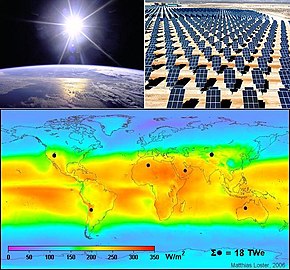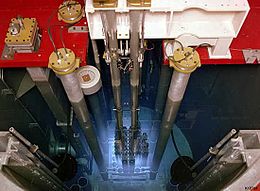
In physics, and in particular as measured by radiometry, radiant energy is the energy of electromagnetic and gravitational radiation. As energy, its SI unit is the joule (J). The quantity of radiant energy may be calculated by integrating radiant flux (or power) with respect to time. The symbol Qe is often used throughout literature to denote radiant energy ("e" for "energetic", to avoid confusion with photometric quantities). In branches of physics other than radiometry, electromagnetic energy is referred to using E or W. The term is used particularly when electromagnetic radiation is emitted by a source into the surrounding environment. This radiation may be visible or invisible to the human eye.
Terminology use and history
The term "radiant energy" is most commonly used in the fields of radiometry, solar energy, heating and lighting, but is also sometimes used in other fields (such as telecommunications). In modern applications involving transmission of power from one location to another, "radiant energy" is sometimes used to refer to the electromagnetic waves themselves, rather than their energy (a property of the waves). In the past, the term "electro-radiant energy" has also been used.
The term "radiant energy" also applies to gravitational radiation. For example, the first gravitational waves ever observed were produced by a black hole collision that emitted about 5.3×10 joules of gravitational-wave energy.
Analysis

Because electromagnetic (EM) radiation can be conceptualized as a stream of photons, radiant energy can be viewed as photon energy – the energy carried by these photons. Alternatively, EM radiation can be viewed as an electromagnetic wave, which carries energy in its oscillating electric and magnetic fields. These two views are completely equivalent and are reconciled to one another in quantum field theory (see wave-particle duality).
EM radiation can have various frequencies. The bands of frequency present in a given EM signal may be sharply defined, as is seen in atomic spectra, or may be broad, as in blackbody radiation. In the particle picture, the energy carried by each photon is proportional to its frequency. In the wave picture, the energy of a monochromatic wave is proportional to its intensity. This implies that if two EM waves have the same intensity, but different frequencies, the one with the higher frequency "contains" fewer photons, since each photon is more energetic.
When EM waves are absorbed by an object, the energy of the waves is converted to heat (or converted to electricity in case of a photoelectric material). This is a very familiar effect, since sunlight warms surfaces that it irradiates. Often this phenomenon is associated particularly with infrared radiation, but any kind of electromagnetic radiation will warm an object that absorbs it. EM waves can also be reflected or scattered, in which case their energy is redirected or redistributed as well.
Open systems
Radiant energy is one of the mechanisms by which energy can enter or leave an open system. Such a system can be man-made, such as a solar energy collector, or natural, such as the Earth's atmosphere. In geophysics, most atmospheric gases, including the greenhouse gases, allow the Sun's short-wavelength radiant energy to pass through to the Earth's surface, heating the ground and oceans. The absorbed solar energy is partly re-emitted as longer wavelength radiation (chiefly infrared radiation), some of which is absorbed by the atmospheric greenhouse gases. Radiant energy is produced in the sun as a result of nuclear fusion.
Applications
Radiant energy is used for radiant heating. It can be generated electrically by infrared lamps, or can be absorbed from sunlight and used to heat water. The heat energy is emitted from a warm element (floor, wall, overhead panel) and warms people and other objects in rooms rather than directly heating the air. Because of this, the air temperature may be lower than in a conventionally heated building, even though the room appears just as comfortable.
Various other applications of radiant energy have been devised. These include treatment and inspection, separating and sorting, medium of control, and medium of communication. Many of these applications involve a source of radiant energy and a detector that responds to that radiation and provides a signal representing some characteristic of the radiation. Radiant energy detectors produce responses to incident radiant energy either as an increase or decrease in electric potential or current flow or some other perceivable change, such as exposure of photographic film.
SI radiometry units
| Quantity | Unit | Dimension | Notes | ||
|---|---|---|---|---|---|
| Name | Symbol | Name | Symbol | ||
| Radiant energy | Qe | joule | J | M⋅L⋅T | Energy of electromagnetic radiation. |
| Radiant energy density | we | joule per cubic metre | J/m | M⋅L⋅T | Radiant energy per unit volume. |
| Radiant flux | Φe | watt | W = J/s | M⋅L⋅T | Radiant energy emitted, reflected, transmitted or received, per unit time. This is sometimes also called "radiant power", and called luminosity in Astronomy. |
| Spectral flux | Φe,ν | watt per hertz | W/Hz | M⋅L⋅T | Radiant flux per unit frequency or wavelength. The latter is commonly measured in W⋅nm. |
| Φe,λ | watt per metre | W/m | M⋅L⋅T | ||
| Radiant intensity | Ie,Ω | watt per steradian | W/sr | M⋅L⋅T | Radiant flux emitted, reflected, transmitted or received, per unit solid angle. This is a directional quantity. |
| Spectral intensity | Ie,Ω,ν | watt per steradian per hertz | W⋅sr⋅Hz | M⋅L⋅T | Radiant intensity per unit frequency or wavelength. The latter is commonly measured in W⋅sr⋅nm. This is a directional quantity. |
| Ie,Ω,λ | watt per steradian per metre | W⋅sr⋅m | M⋅L⋅T | ||
| Radiance | Le,Ω | watt per steradian per square metre | W⋅sr⋅m | M⋅T | Radiant flux emitted, reflected, transmitted or received by a surface, per unit solid angle per unit projected area. This is a directional quantity. This is sometimes also confusingly called "intensity". |
| Spectral radiance Specific intensity |
Le,Ω,ν | watt per steradian per square metre per hertz | W⋅sr⋅m⋅Hz | M⋅T | Radiance of a surface per unit frequency or wavelength. The latter is commonly measured in W⋅sr⋅m⋅nm. This is a directional quantity. This is sometimes also confusingly called "spectral intensity". |
| Le,Ω,λ | watt per steradian per square metre, per metre | W⋅sr⋅m | M⋅L⋅T | ||
| Irradiance Flux density |
Ee | watt per square metre | W/m | M⋅T | Radiant flux received by a surface per unit area. This is sometimes also confusingly called "intensity". |
| Spectral irradiance Spectral flux density |
Ee,ν | watt per square metre per hertz | W⋅m⋅Hz | M⋅T | Irradiance of a surface per unit frequency or wavelength. This is sometimes also confusingly called "spectral intensity". Non-SI units of spectral flux density include jansky (1 Jy = 10 W⋅m⋅Hz) and solar flux unit (1 sfu = 10 W⋅m⋅Hz = 10 Jy). |
| Ee,λ | watt per square metre, per metre | W/m | M⋅L⋅T | ||
| Radiosity | Je | watt per square metre | W/m | M⋅T | Radiant flux leaving (emitted, reflected and transmitted by) a surface per unit area. This is sometimes also confusingly called "intensity". |
| Spectral radiosity | Je,ν | watt per square metre per hertz | W⋅m⋅Hz | M⋅T | Radiosity of a surface per unit frequency or wavelength. The latter is commonly measured in W⋅m⋅nm. This is sometimes also confusingly called "spectral intensity". |
| Je,λ | watt per square metre, per metre | W/m | M⋅L⋅T | ||
| Radiant exitance | Me | watt per square metre | W/m | M⋅T | Radiant flux emitted by a surface per unit area. This is the emitted component of radiosity. "Radiant emittance" is an old term for this quantity. This is sometimes also confusingly called "intensity". |
| Spectral exitance | Me,ν | watt per square metre per hertz | W⋅m⋅Hz | M⋅T | Radiant exitance of a surface per unit frequency or wavelength. The latter is commonly measured in W⋅m⋅nm. "Spectral emittance" is an old term for this quantity. This is sometimes also confusingly called "spectral intensity". |
| Me,λ | watt per square metre, per metre | W/m | M⋅L⋅T | ||
| Radiant exposure | He | joule per square metre | J/m | M⋅T | Radiant energy received by a surface per unit area, or equivalently irradiance of a surface integrated over time of irradiation. This is sometimes also called "radiant fluence". |
| Spectral exposure | He,ν | joule per square metre per hertz | J⋅m⋅Hz | M⋅T | Radiant exposure of a surface per unit frequency or wavelength. The latter is commonly measured in J⋅m⋅nm. This is sometimes also called "spectral fluence". |
| He,λ | joule per square metre, per metre | J/m | M⋅L⋅T | ||
| See also: | |||||
- Standards organizations recommend that radiometric quantities should be denoted with suffix "e" (for "energetic") to avoid confusion with photometric or photon quantities.
- ^ Alternative symbols sometimes seen: W or E for radiant energy, P or F for radiant flux, I for irradiance, W for radiant exitance.
- ^ Spectral quantities given per unit frequency are denoted with suffix "ν" (Greek letter nu, not to be confused with a letter "v", indicating a photometric quantity.)
- ^ Spectral quantities given per unit wavelength are denoted with suffix "λ".
- ^ Directional quantities are denoted with suffix "Ω".
See also
- Luminous energy
- Luminescence
- Power
- Radiometry
- Federal Standard 1037C
- Transmission
- Open system
- Photoelectric effect
- Photodetector
- Photocell
- Photoelectric cell
Notes and references
- "Radiant energy". Federal standard 1037C
- George Frederick Barker, Physics: Advanced Course, page 367
- Hardis, Jonathan E., "Visibility of Radiant Energy". PDF.
- Examples: US 1005338 "Transmitting apparatus", US 1018555 "Signaling by electroradiant energy", and US 1597901 "Radio apparatus".
- Kennefick, Daniel (2007-04-15). Traveling at the Speed of Thought: Einstein and the Quest for Gravitational Waves. Princeton University Press. ISBN 978-0-691-11727-0. Retrieved 9 March 2016.
- Sciama, Dennis (17 February 1972). "Cutting the Galaxy's losses". New Scientist: 373. Retrieved 9 March 2016.
- Abbott, B.P. (11 February 2016). "Observation of Gravitational Waves from a Binary Black Hole Merger". Physical Review Letters. 116 (6): 061102. arXiv:1602.03837. Bibcode:2016PhRvL.116f1102A. doi:10.1103/PhysRevLett.116.061102. PMID 26918975.
- Moran, M.J. and Shapiro, H.N., Fundamentals of Engineering Thermodynamics, Chapter 4. "Mass Conservation for an Open System", 5th Edition, John Wiley and Sons. ISBN 0-471-27471-2.
- Robert W. Christopherson, Elemental Geosystems, Fourth Edition. Prentice Hall, 2003. Pages 608. ISBN 0-13-101553-2
- James Grier Miller and Jessie L. Miller, The Earth as a System Archived 2021-04-22 at the Wayback Machine.
- Energy transformation. assets.cambridge.org. (excerpt)
- US 1317883 "Method of generating radiant energy and projecting same through free air for producing heat"
- Class 250, Radiant Energy Archived 2009-07-03 at the Wayback Machine, USPTO. March 2006.
- Lang, Kenneth R. (1999). Astrophysical Formulae. Berlin: Springer. ISBN 978-3-540-29692-8.
- Mischler, Georg (2003). "Radiant energy". Lighting Design Knowledgebase. Retrieved 29 Oct 2008.
- Elion, Glenn R. (1979). Electro-Optics Handbook. CRC Press Technology & Industrial Arts. ISBN 0-8247-6879-5.
Further reading
- Caverly, Donald Philip, Primer of Electronics and Radiant Energy. New York, McGraw-Hill, 1952.
- Whittaker, E. T. (Apr 1929). "What is energy?". The Mathematical Gazette. 14 (200). The Mathematical Association: 401–406. doi:10.2307/3606954. JSTOR 3606954. S2CID 187889019.
| Radio spectrum (ITU) | |||||||||||||
|---|---|---|---|---|---|---|---|---|---|---|---|---|---|
| |||||||||||||
